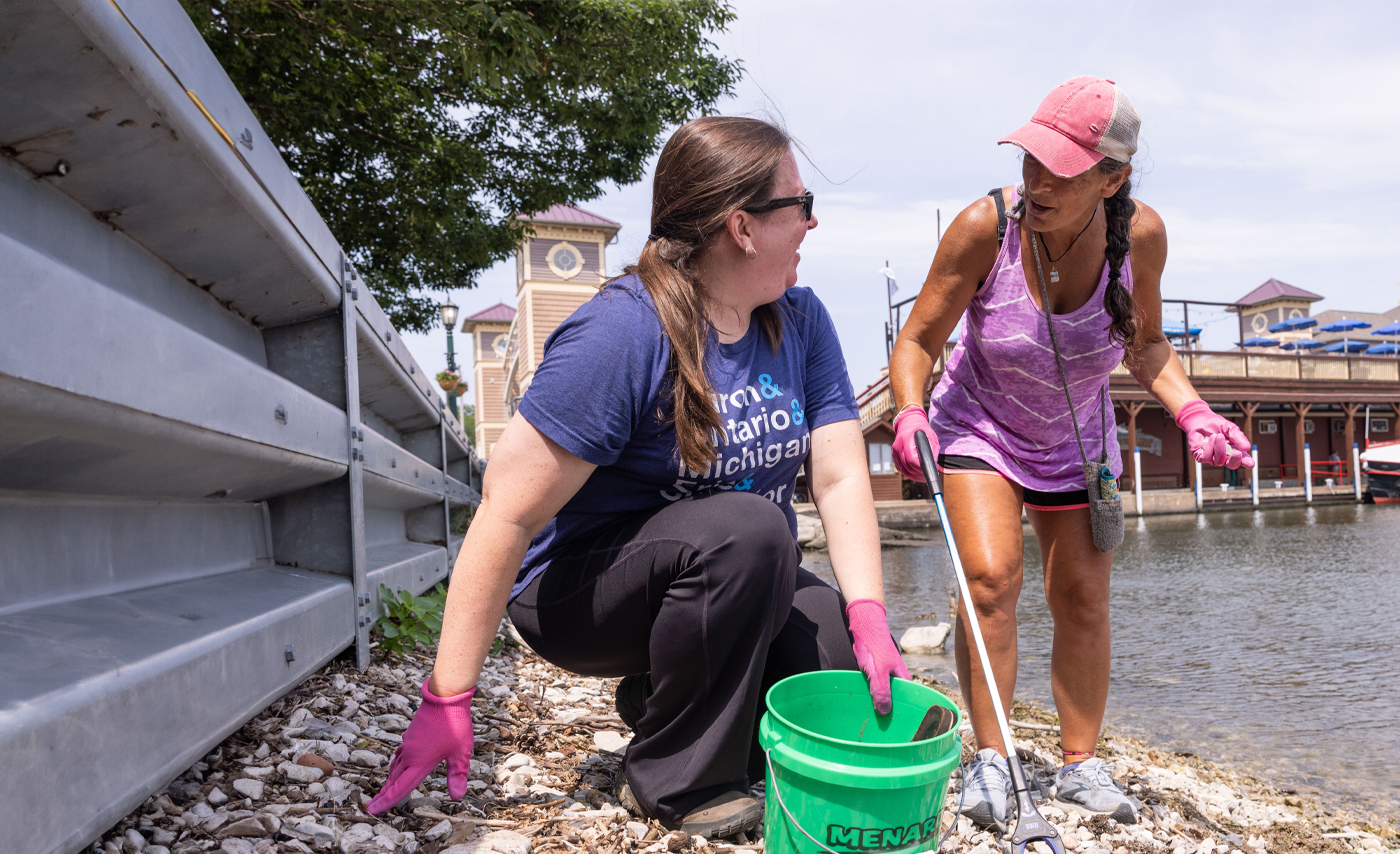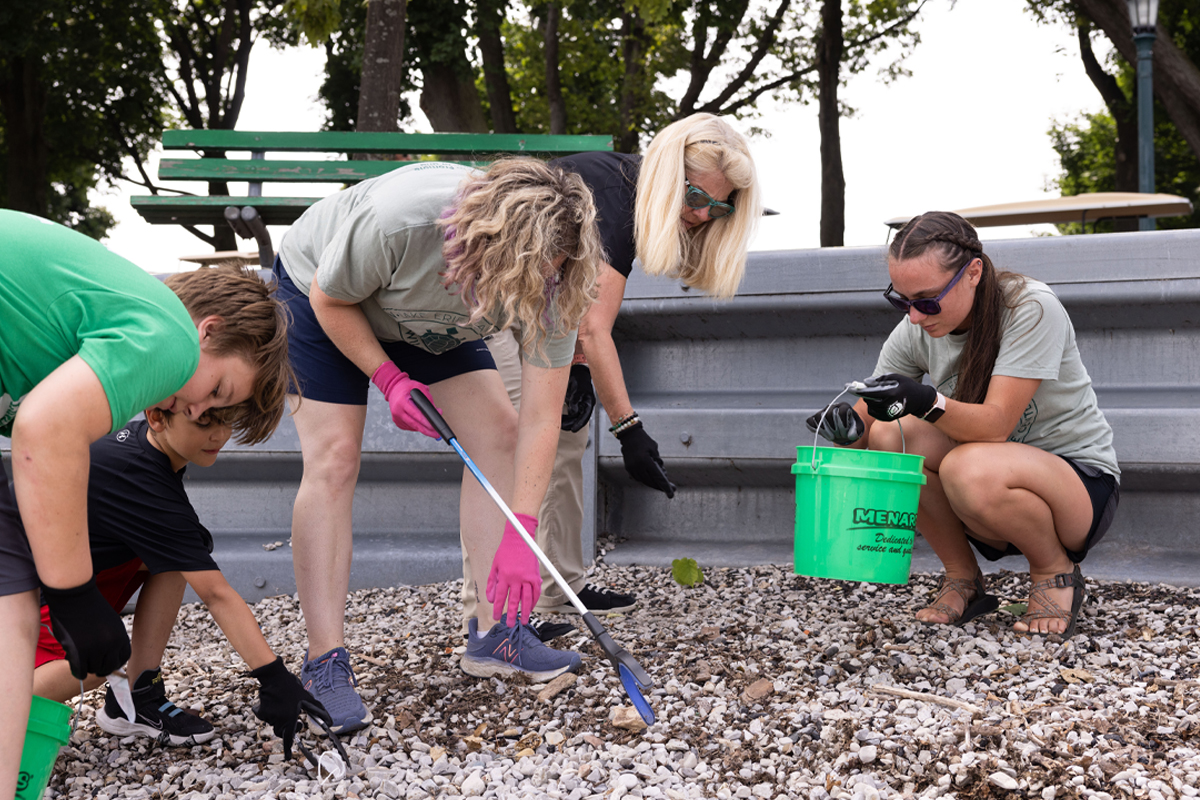Cleaning up our Great Lake
Using one Lake Erie island as its testing ground, Ohio State educators have created a model program for eliminating freshwater plastic debris.

Until recent years, it was common for the people living on South Bass Island — home to the popular tourist spot Put-in-Bay — to see shorelines and green spaces littered with plastic straws and cigarette butts, or to see bottle caps and plastic bottles in the water of their Lake Erie home.
A few years back, Jill Bartolotta organized an island-wide effort to do something about it. As an extension educator for Ohio State’s Stone Laboratory and Ohio Sea Grant (both part of the College of Food, Agricultural, and Environmental Sciences), she promotes sustainable practices around Lake Erie.
Through a National Oceanic and Atmospheric Administration (NOAA) grant, Bartolotta and Susan Bixler, the program’s education specialist, created an ongoing sustainability plan for a clean island.
“I grew up on Lake Erie, it’s my home, I’ve seen how it’s changed in my lifetime,” Bartolotta says. “What we’re doing here is incredibly important. I love this lake and I want to make sure it’s clean for future generations.”
The clean-up effort, which began in 2018, is important any way you slice it. Studies have shown tourists hate trash, dangerous for the local economy of a place like Put-in-Bay, which welcomes about 800,000 tourists each year at Lake Erie. The lake also supports a $2 billion sport fishing industry.
From a health standpoint, microplastics — often the result of larger plastic products breaking down — are dramatically increasing in animals and humans, potentially causing a variety of health issues for the 13 million people who get their drinking water from Lake Erie.
“There was a major issue here with plastics,” Bartolotta says. “But we had incredible support and it was very effective. Of all the projects I’ve done, by far I’ve been happiest with this one.”
The project spanned 2018-21 and has become a model program for other Sea Grant agencies, and even international organizations seeking to clean up bodies of freshwater. And while the grant has ended, many of the efforts remain, such as these:
Beach Cleanups
Volunteers from across the island — Ohio State extension educators, students and faculty, island residents, high school students and teachers and restaurant owners and staff — worked together in numerous beach and shoreline cleanups.
Those volunteers restored over 60 acres of land, removing nearly 600 pounds of trash. They also found, through surveys, that awareness of marine debris has increased dramatically, while use of single-use plastics dropped significantly.
“When we first started doing beach cleanups, it was amazing the amount of plastics we found. You really didn’t know how much was there until you started combing through it,” says Eric Booker, who owns multiple restaurants on the island and had 200 employees help in the cleanups.
“I’ve lived here my whole life, raised three boys on the island and the last five years you see a visible change in the cleanup of the lake. It’s a feel-good moment for all of us.”

Skip the Straw campaign
A major part of the effort included working with island restaurants, such as Booker’s establishments, to cut down on single-use plastic. The prime item? Plastic straws.
Not only did restaurants cut plastic use by over 90 percent by switching to paper and biodegradable items, but they also included information about plastic reduction on menus and spoke to patrons about sustainability practices. According to Booker, staff members said patrons were overwhelmingly receptive — there was no lost business and tips didn’t decline.
Trash Totes
As part of educational outreach, the team developed “Trash Tote” bags that were distributed to education partners across the island, around the Great Lakes and throughout Ohio to educate people about freshwater marine debris.
The large totes feature cleanup kits and examples of commonly found plastics, show reusable alternatives and include educational cards that illustrate the impact of pollution and give calls to action.
“As an educational tool, the Trash Tote was very effective,” Bartolotta says. “People love them. They’re especially important because it highlights the issue in freshwater. Most of what you see is ocean-focused, but this lets people know it is an issue in our own backyard, in the Great Lakes.”
Messaging and signage
Visitors to the island are encouraged to keep the island clean immediately. The Jet Express ferry plays a recorded message about marine debris while Miller Ferry docks have cigarette receptacles with signs urging cleaner practices. There has been a significant reduction in the number of cigarette butts littering walkways to ferries since the signs have been put in place. The signs are being used statewide by cities and state parks.
There are similar receptacles and messaging throughout the island. One highlight is at the Ohio Division of Wildlife Aquatic Visitors Center, where an entire exhibit educated the public about marine debris and provided solutions tourists could incorporate into their everyday lives.
“One of our goals was takeaways,” says Julene Market, co-owner of Miller Ferry, which boats tourists to Put-in-Bay. “People come here on vacation, they see the signage, get the education implanted in their heads that we have to take care of our planet. Ideally this becomes part of their lifestyle after they leave here.”